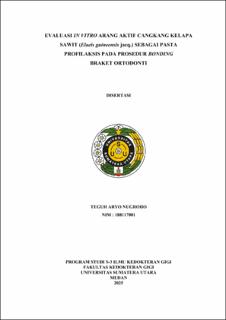Evaluasi In Vitro Arang Aktif Cangkang Kelapa Sawit (Elaeis Guineensis Jacq.) Sebagai Pasta Profilaksis pada Prosedur Bonding Braket Ortodonti
In Vitro Evaluation of Palm Kernel Shell Activated Charcoal (Elaeis guineensis jacq.) as Prophylaxis in Orthodontic Bracket Bonding Procedures

Date
2025Author
Nugroho, Teguh Aryo
Advisor(s)
Pintauli, Sondang
Narmada, Ida Bagus
Reveny, Julia
Metadata
Show full item recordAbstract
Background: Prophylaxis procedures before the placement of orthodontic brackets are important to remove the smear layer from enamel surface, optimize the bracket’s shear bond strength, and prevent demineralization on the enamel surface. The selection of prophylaxis paste is based on the abrasive properties, antibacterial effectiveness, and its impact on the enamel. Activated charcoal from palm kernel shell (Elaeis guineensis jacq.) has the antibacterial potential and high absorption capacity, which can be promising for use as an ingredient in prophylaxis paste. Aims: To evaluate the potential of activated charcoal paste from palm kernel shell as prophylaxis ingredients on the orthodontic bracket bonding procedures, based on the following parameters: bacterial adhesion, shear bond strength, and changes in enamel surface roughness. Research methods: This was a laboratory experimental study done in stages including the formulation of activated charcoal paste with 10 and 12% concentration. The paste was then applied as prophylaxis ingredients before the placement of orthodontic brackets, followed by soaking in artificial saliva contaminated by Streptococcus mutans for 28 days. The tests for bacterial adhesion, shear bond strength, and enamel surface roughness were analyzed and compared with the positive control group. Results: Bacterial adhesion test showed the 10% activated charcoal paste group was not significantly different to the positive control, while the 12% paste group had a significantly less bacterial adhesion than the positive control. Shear bond strength test showed both 10 and 12% activated charcoal paste group were significantly higher than the positive control. No significant difference was observed between the 10 and 12% activated charcoal paste group and the positive control. Conclusion: Activated charcoal paste from palm shell kernel (Elaeis guineensis jacq.) with 12% concentration, when combined with 10% polyacrylic acid etching, can be used as prophylaxis ingredients effective for orthodontic bracket bonding procedure. This paste can prevent bacterial adhesion, provide adequate shear bond strength, and minimize changes in enamel surface roughness compared to 37% phosphoric acid etching.
